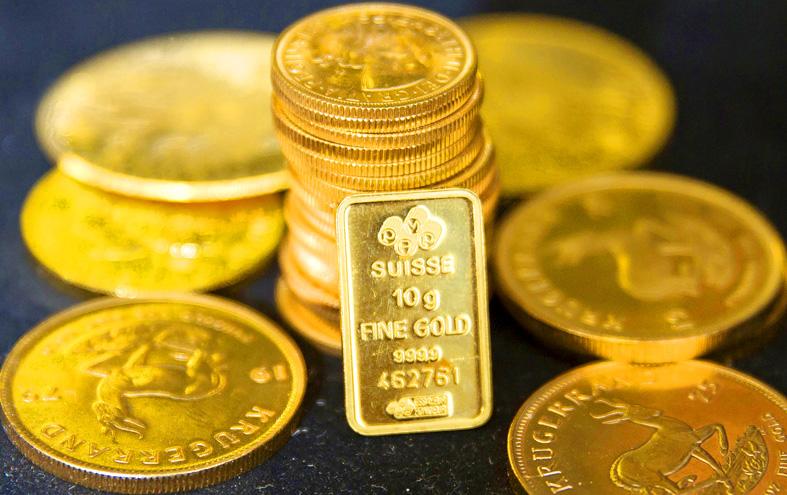Gold rose to a one-month high after the US Federal Reserve reiterated its commitment to supporting the economy and optimism grew that a virus-relief package would soon be delivered by US lawmakers.
The Fed promised at its final policy meeting for this year to maintain its massive asset-purchase program until it sees “substantial further progress” in employment and inflation.
Fed Chairman Jerome Powell said that the case for fiscal stimulus was “very, very strong.”

Photo: Reuters
Congressional leaders are also working through the final sticking points of a COVID-19 relief deal.
“This move right now is all predicated on stimulus and Powell’s comments yesterday: It feels like gold’s back in favor,” RJO Futures senior market strategist Bob Haberkorn said. “This time of the year, gold usually starts to move higher and it’ll go up until early February. You throw in a seasonal trade there, coupled with stimulus that’s coming and the Fed that’s been pretty supportive — it’s kind of turned into a perfect storm for gold bulls.”
Bullion is set to finish this year with the biggest annual gain in a decade as concern over the economic impact of COVID-19 underpins demand for the metal as a haven.
Powell said that the ongoing surge in new COVID-19 cases is “particularly concerning,” and made clear that the central bank would be in no hurry to pull back on the massive stimulus it is providing to the economy as growth picks up.
“Listening to the Fed’s view, it is pretty much clear now that gold prices are likely to continue to move higher as the Fed is in no rush at all to do anything anytime soon,” Ava Trade chief market analyst Naeem Aslam said in a note. “So for now, the path of the least resistance in terms of the gold price is skewed to the upside.”
Spot gold rose 1.08 percent to US$1,884.26 an ounce after touching US$1,896.26, the highest since Nov. 16.
The precious metal has climbed 24 percent this year.
Futures for February delivery rose 1.7 percent to settle at US$1,890.40 an ounce. Silver, platinum and palladium also advanced.
Other commodities:
‧ Copper topped US$8,000 a ton (US$7,257.48 a tonne) for the first time in more than seven years,.
Copper’s fierce ascent to US$8,000 this week “is really boosted by hopes on the US stimulus talks,” TD Securities analyst Ryan McKay said.
“The China recovery scenario, a weaker dollar and green-inspired reflation wave have also lifted copper, especially with the Chinese stockpiling impulse having been bigger than initially thought and more strategic in nature,” McKay said.
The gains come amid calls by Goldman Sachs and BlackRock Inc of a new long-term bull market. Prices are in the sharpest rally in more than a decade, with China’s appetite for commodities and supply snags early on in the COVID-19 pandemic lifting copper about 80 percent from its March lows.
Expectations for a deficit, the weaker US dollar, and its role in green technology have also fueled gains.
Some banks and investors are now drawing comparisons to the spike in the early 2000s, when a jump in Chinese orders ushered in the last super-cycle for commodities.
“You have all the tell-tale signs of a super-cycle,” Jeff Currie, head of commodities research at Goldman Sachs, told Bloomberg TV.
Additional reporting by Reuters

The New Taiwan dollar is on the verge of overtaking the yuan as Asia’s best carry-trade target given its lower risk of interest-rate and currency volatility. A strategy of borrowing the New Taiwan dollar to invest in higher-yielding alternatives has generated the second-highest return over the past month among Asian currencies behind the yuan, based on the Sharpe ratio that measures risk-adjusted relative returns. The New Taiwan dollar may soon replace its Chinese peer as the region’s favored carry trade tool, analysts say, citing Beijing’s efforts to support the yuan that can create wild swings in borrowing costs. In contrast,

Nvidia Corp’s demand for advanced packaging from Taiwan Semiconductor Manufacturing Co (TSMC, 台積電) remains strong though the kind of technology it needs is changing, Nvidia CEO Jensen Huang (黃仁勳) said yesterday, after he was asked whether the company was cutting orders. Nvidia’s most advanced artificial intelligence (AI) chip, Blackwell, consists of multiple chips glued together using a complex chip-on-wafer-on-substrate (CoWoS) advanced packaging technology offered by TSMC, Nvidia’s main contract chipmaker. “As we move into Blackwell, we will use largely CoWoS-L. Of course, we’re still manufacturing Hopper, and Hopper will use CowoS-S. We will also transition the CoWoS-S capacity to CoWos-L,” Huang said

Nvidia Corp CEO Jensen Huang (黃仁勳) is expected to miss the inauguration of US president-elect Donald Trump on Monday, bucking a trend among high-profile US technology leaders. Huang is visiting East Asia this week, as he typically does around the time of the Lunar New Year, a person familiar with the situation said. He has never previously attended a US presidential inauguration, said the person, who asked not to be identified, because the plans have not been announced. That makes Nvidia an exception among the most valuable technology companies, most of which are sending cofounders or CEOs to the event. That includes

INDUSTRY LEADER: TSMC aims to continue outperforming the industry’s growth and makes 2025 another strong growth year, chairman and CEO C.C. Wei says Taiwan Semiconductor Manufacturing Co (TSMC, 台積電), a major chip supplier to Nvidia Corp and Apple Inc, yesterday said it aims to grow revenue by about 25 percent this year, driven by robust demand for artificial intelligence (AI) chips. That means TSMC would continue to outpace the foundry industry’s 10 percent annual growth this year based on the chipmaker’s estimate. The chipmaker expects revenue from AI-related chips to double this year, extending a three-fold increase last year. The growth would quicken over the next five years at a compound annual growth rate of 45 percent, fueled by strong demand for the high-performance computing